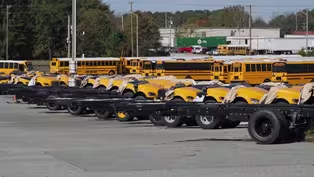
How This Neighborhood is Outsmarting the Power Grid
Clip: 2/7/2025 | 7m 22sVideo has Closed Captions
Brunswick County turns to microgrids for energy independence amid aging power infrastructure.
Discover how communities achieve energy independence through microgrids as America's power infrastructure struggles with extreme weather and rising demand. From a North Carolina coastal town's self-powered system to farms combining biogas and solar power, these local energy networks offer innovative solutions to our aging grid challenges.
Problems playing video? | Closed Captioning Feedback
Problems playing video? | Closed Captioning Feedback
ncIMPACT is a local public television program presented by PBS NC

How This Neighborhood is Outsmarting the Power Grid
Clip: 2/7/2025 | 7m 22sVideo has Closed Captions
Discover how communities achieve energy independence through microgrids as America's power infrastructure struggles with extreme weather and rising demand. From a North Carolina coastal town's self-powered system to farms combining biogas and solar power, these local energy networks offer innovative solutions to our aging grid challenges.
Problems playing video? | Closed Captioning Feedback
How to Watch ncIMPACT
ncIMPACT is available to stream on pbs.org and the free PBS App, available on iPhone, Apple TV, Android TV, Android smartphones, Amazon Fire TV, Amazon Fire Tablet, Roku, Samsung Smart TV, and Vizio.
Providing Support for PBS.org
Learn Moreabout PBS online sponsorship[light music] - Just as Americans are encouraged to go electric, our power grid is failing.
Aging infrastructure, extreme weather, and surging demand are pushing our century-old power grid to its breaking point.
But what if the solution isn't about fixing the old system, but creating something new?
In this video, we're diving into the world of microgrids and how some communities are taking power into their own hands, literally.
We'll explore a coastal community that's become its own miniature power plant.
But can they truly answer our massive energy challenges?
Let's find out.
[upbeat music] [light music] In 2022, Eric Moulder and his wife were looking to downsize from their Pennsylvania home.
Like many retirees, they wanted a place near the beach, but they also wanted a house that could help them break away from an aging power grid.
- I've always wanted to have solar on my house.
I always knew the benefits of having solar.
- [David] The Moulders want energy independence, and so do a lot of other people.
The average American spends more time without power now than they did a decade ago.
Hurricane Helene's widespread blackouts made national news, but it wasn't an isolated crisis.
Communities face more and more threats to their power supply.
Media reported that in December of 2022, Moore County, North Carolina saw just how vulnerable our grid can be.
Gunfire damaged two critical substations and 45,000 people lost power.
One resident who depended on an oxygen tank died during the blackout.
Later that same month, Winter Storm Elliott brought freezing temperatures and soaring energy demand.
For the first time in North Carolina's history, Duke Energy implemented rolling blackouts, and they did it on Christmas Eve.
It was all in an effort to protect the overwhelmed power grid.
But I'm curious, with technology advancing, why is it that our grid is worse now than it was a decade ago?
The short answer is rapid population growth, an influx of businesses, and the electrification of transportation.
It's all straining North Carolina's grid like never before.
Duke Energy even recently reported that electricity demand is growing at its fastest rate in three decades.
But check out this solution: the microgrid.
It's a local power network that can operate independently from the larger grid.
It uses renewable energy sources like solar arrays and then banks power in batteries for later use.
The Heron's Nest community pioneered this concept as the state's first residential microgrid.
It's in Shallotte, North Carolina, and the Moulders are one of the community's first residents.
- Now that we're in the backyard, you can see the panels up there.
We have 10 panels on every home in the community.
- [David] Each of the neighborhood's 31 homes features a rooftop solar system.
It helps residents save money while also reducing their carbon footprint.
At the front of the neighborhood, we find more solar panels and a giant battery, all built on land that can't be developed.
The system is maintained by Brunswick Electric and stores enough power that, if needed, it can serve the entire community.
- And a lot of developments really have that.
You know, they've got the land that's left over.
It's not gonna be really useful for anything.
And so we decided to take that, and along with Brunswick Electric, use that to add something to the community that's helpful for the community when the power's out, but it is also helpful to the utility to keep electricity rates low for their customers.
- [David] While most homeowners rely on generators for backup power, this system offers a different solution during outages.
- You know, it gives you a certain amount of security knowing that if the electric goes down, we will be able to have power for a while, for those first 24 hours or so.
- And how important is that living in a coastal community where those outages might be a little bit more frequent?
- Yeah, I mean, we're in Hurricane Alley, right?
So it just makes perfect sense.
[light music] - Okay, now let's talk money.
Not only does solar reduce energy bills by about 1/3, but when these homes generate more electricity than they need, Brunswick Electric buys it back.
- And in all honesty, there's plenty of months in the moderate months, spring and fall, where people virtually haven't had a power bill.
[birds chirping] - [David] All of that sounds pretty good, especially that part about not having a power bill.
But there are shortcomings with microgrids.
Their widespread adoption faces financial and regulatory hurdles.
You see, the very things that make microgrids attractive, such as their independence and flexibility, also make them hard to regulate.
And that means there just isn't much incentive for builders to implement microgrids, especially at an affordable price point.
- We look around the country, you know, there's several of these around the country, but a lot of times, they're in communities, million-dollar homes that are gated.
And frankly, that's not very affordable.
It's for the ordinary person, it's very distant.
[light music] - But several states, including North Carolina, have already taken steps to make this process a little bit easier.
Across the country, new solutions are making microgrids more achievable than ever.
States are beginning to create clear rules that tell developers exactly how to build and connect these systems.
Meanwhile, innovative financing programs are eliminating the need for huge upfront costs.
It's making microgrids more affordable for communities that need them.
But so far, all we've talked about is residential.
How can microgrids be implemented in other sectors?
Well, electric co-ops across the state are exploring just that.
- This idea is scalable and certainly able to duplicate, and we can take what we've learned here and improve them in the future.
And we do have five current microgrids that have been deployed by North Carolina's electric cooperatives.
- Those five projects include two residential, two on farms, and one community project.
Take, for example, Butler Farms in Lillington, North Carolina.
They've partnered with their local electric co-op to create a microgrid that combines solar panels, batteries, and get this, pig poop.
Yeah, you heard that right, pig poop.
By converting their farm's waste into biogas, they're not just keeping their own lights on during outages, but they can also sell their excess power back to the grid.
On a larger scale, Duke Energy has unveiled a $14.5 million microgrid project in Hot Springs, North Carolina.
It will serve as a reliable power solution to the Hot Springs area, with the added benefit of supplying electricity to the entire town during outages.
Meanwhile, Eric Moulder is experiencing firsthand the benefits of microgrids through less power outages and cheaper energy bills.
In Pennsylvania, his average power bill was $400 a month.
Now, it's about 70.
Any sort of reaction from guests or people who come by and see it for the first time?
- I mean, they would never know, really.
But when we start talking and I say, "Yeah, my electric bills was, you know, $58 this month," they're like, "What?"
[laughing] So I mean, that's the reaction you get.
- [David] But that's just one household.
The road to widespread adoption has some obstacles.
Financial hurdles and regulatory mazes pose significant challenges to scaling up this promising technology.
For "ncIMPACT," I'm David Hurst.
Inside One of America's Most Advanced Water Rescue Training Facilities
Video has Closed Captions
Clip: 2/7/2025 | 8m 8s | Explore Fayetteville Tech's swift water rescue training facility. (8m 8s)
Inside the Electric School Bus Experiment
Video has Closed Captions
Clip: 2/7/2025 | 5m 43s | Cabarrus County schools swap diesel buses for electric fleets, transforming student transportation. (5m 43s)
Preview | Energy and the Environment
Video has Closed Captions
Preview: 2/7/2025 | 30s | In a storm-ravaged state, communities find ways to save lives and build toward an uncertain future. (30s)
Providing Support for PBS.org
Learn Moreabout PBS online sponsorship
- News and Public Affairs

Top journalists deliver compelling original analysis of the hour's headlines.

- News and Public Affairs

FRONTLINE is investigative journalism that questions, explains and changes our world.












Support for PBS provided by:
ncIMPACT is a local public television program presented by PBS NC


